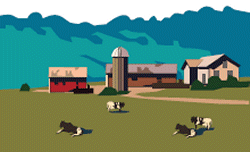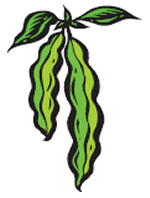

To send a message to an author, click on the author's name at the end of the article.
This Month in Ag Connection | Ag Connection - Other Issues Online
Fall herbicide applications were first used by producers and commercial applicators to spread out their workloads and remove at least one of the tasks that would normally be done in the spring. This was due to the number of suitable field workdays during March and April as a result of rainfall received in the spring.
As the practice continued, an additional benefit of the spring soil condition was recognized. Research from the University of Missouri revealed the removal of winter annual weeds resulted in higher soil temperatures when compared to areas with dense infestations of winter annual weeds. In their experiments winter annual weed removal increased soil temperatures by as much as 5 degrees in corn and by as much as 8 degrees in soybeans.

The presence of weeds also reduced the soil moisture content at the time of planting. The research revealed soil moisture content at planting was as much as 13% higher in corn and 6% higher in soybean when weeds were controlled with a fall herbicide application.
Research from Kansas State University revealed winter annual weeds are also likely to remove available nitrogen (N) from the soil. The average N uptake from winter annual weeds was approximately 16 pounds per acre averaged across 14 locations.
Another consideration for fall weed control is that many winter annual weeds can serve as alternate hosts for soybean cyst nematode (SCN). Research has shown purple deadnettle and henbit are considered strong hosts for SCN, while field pennycress has been classified as a moderate host. Shepherd's purse, small- flowered bittercress, and common chickweed are considered weak hosts. Also, fields with henbit and other winter annual weeds that are flowering in the early spring are attractive sites for black cutworm moths to lay their eggs. Research at the University of Missouri has also revealed winter annual weeds can serve as alternative hosts for corn flea beetles and some other Lepidopteron insects.
Some points to remember.
Source: Wayne Crook, Agronomy Specialist
This Month in Ag Connection | Ag Connection - Other Issues Online
The digital world provides many opportunities to access information. One daily electronic newsletter recently had an article highlighting how nutrient restriction can impact beef cow reproductive performance and ranch finances. The article was written by Dr. Les Anderson, Extension Beef Specialist at the University of Kentucky and appeared in the September 11, 2013 edition of the Drovers CattleNetwork newsletter.

As Dr. Anderson explained, this real-world situation occurred in Kentucky in a herd of 100 fall calving cows. Fall pasture was limited and hay quality was poor, averaging 82% of the energy required for lactating beef cows. Due to tight finances, only hay was fed to the cows, and no additional supplements were fed.
Cows began calving in September in a body condition score 5, but due to the poor quality hay, lost about one body condition score in two months. Cows were synchronized and time-bred using artificial insemination (AI) in November. Clean-up bulls ran with the herd for an additional 60 days after the timed AI. Body condition score at AI was 4. The cows continued to lose body condition throughout the breeding season.
Pregnancy exams were done 40 days after the timed AI date. Pregnancy examination revealed 29 cows conceived to AI, 31 cows conceived to natural service by the clean-up bulls, and 40 cows were open. Pregnancy examination occurred before the end of the breeding season, but was highly unlikely that a large number of the open cows would have bred during the last 20 days of the breeding season, after having failed three times to become pregnant.
Dr. Anderson continued by considering only the 40 open cows. He assumed under normal circumstances, seven cows would have been open anyway, based on a 93% conception rate for the herd. That means 33 calves were lost due to nutritional mismanagement. Assuming average weaning weights and current market prices for steer and heifer calves, this producer lost $26,200 in gross income on the 33 calves that were not conceived. Based on supplement cost and feeding rate necessary to maintain body condition score of the lactating cows, supplemental feed costs were calculated to be $11,070 for 123 days of feeding.
This producer lost over $15,000 due to the management mistake of not properly supplementing his cow herd. The producer also spent $4,000 on the timed AI program carried out under circumstances with very little chance of success. Timed AI does not work very effectively when cows are losing weight and is a poor decision in a nutritionally mismanaged situation. Poor decisions about feeding and breeding programs cost this producer over $19,000 in lost revenue and ill-advised expense.
How does this relate to our current situation? Hay quality is relatively poor this year, based on early, limited hay analysis. In fact, the average hay quality is very close to the quality of hay fed on this Kentucky farm. The good news is that supplemental energy and protein sources are lower cost than last year. Should you be supplementing your fall calving cows? Considering your winter feeding programs, can you afford to be penny wise, by not feeding adequate diets, and pound foolish, by reducing reproductive performance?
Source: Gene Schmitz, Livestock Specialist
This Month in Ag Connection | Ag Connection - Other Issues Online
In recent years, we have seen increasing damage to crops from herbicide- contaminated soil which was brought into a crop-growing area, or even compost, that contained enough herbicide to cause significant damage to crops. "The culprit can be one of any three herbicides which have been approved for use on pastures and forage crops," said David Trinklein, University of Missouri Extension horticulture specialist. Newer versions of herbicides with active ingredients such as clopyralid, picloram and aminopyralid can pass through the digestive systems of foraging animals and arrive, unchanged, in the manure. If that manure is composted, gardeners could unwittingly introduce these plant- killing compounds into their soil.
"My first encounter with this was with a gentleman in northwestern Missouri who was using buffalo manure for composting," Trinklein said.

"We were able to demonstrate, on tomato, that there was something in the compost." So why not just test compost before selling it? Commercial testing for these chemicals is costly. The test is between $300 and $400 per chemical. Say you test for picloram and it's not found in the sample. You'll have to spend another $400 to test for another chemical. You would have to keep testing until you find the culprit. Meanwhile, you've spent $400 a test.
It's not just compost. These herbicides can show up in mulch too. Let's say a farmer put up hay but it got wet. Normally that would be great for mulch. But if that hay had been treated with picloram, avoid using it since there is the potential for the herbicide to leach into the soil and harm plants. Once these herbicides have been added to the soil, through compost or mulch, there aren't many options for correcting the problem. Producers can remove and replace the soil, but that is expensive, labor-intensive and time-consuming. You also have the option to wait until soil microbes break down the herbicides naturally, but these new-generation herbicides have lengthy half-lives of months to years. These herbicides ultimately will break down, but it might take a couple of years, depending on the concentration. We hope in most cases we could plant the following year, but one may want to avoid herbicide-sensitive plants, such as tomato.

The good news is there is a simple and inexpensive way to test for these compounds. Take green bean seeds and plant them into the compost. Green beans are very sensitive to herbicide. If the seedlings come up okay, the compost is good. If they come up twisted and damaged, allow the compost to age until the herbicide is broken down. It is important not to panic. We don't want to dissuade people from using compost and organic matter. They are the gardener's best friend when it comes to building healthy soil. Gardeners should find out whether the compost supplier has used animal manure, and if so, make sure the animals have not been fed forages sprayed with these herbicides. In this situation, being informed and proactive is your best defense. Vegetable growers should use the green bean test before they work compost into the soil. Also, talk with your supplier and make sure they are aware of the problem and discuss the steps they are taking to avoid it.
Story source: Dr. David Trinklein, State Extension Horticulture Specialist
This Month in Ag Connection | Ag Connection - Other Issues Online
As winter inches closer, producers should look at hay storage and winter feeding plans. Hay resources are better than last year however, producers need to be mindful on ways to prevent hay shortages. Make sure storage and feeding losses are taken into consideration as calculations are made on how much hay is needed for the winter. Storage and feeding waste can take a significant toll on
hay supplies and producers need to be more aware of the impacts these losses can have on hay supplies. For instance, if hay is stored on the ground outside, without a cover, hay losses can run as high as 20 to 30% before it is fed. According to the Missouri Hay Summary (www.ams.usda.gov/mnreports/jc_gr3 10.txt), "fair quality mixed grass hay" is averaging $70.00 per ton or approximately $35.00/bale, when averaging for 25% hay storage loss that amounts to 250 pounds/bale or about $10.00/bale.
The manner in which hay is fed also plays a role in the amount of waste. Allowing unrestricted access to hay can result in another 20% hay loss, according to Dr. Justin Sexten, MU Extension State Beef Specialist. If producers lose 25% from storage losses and another 20% from feeding losses, almost half the hay is gone before the hay is fed to the livestock. In the example with $35.00 hay this would result in $15.75/bale lost to storage and feeding. If the producer feeds 100 bales this would equal $1575.00. At these prices it does not take long for better storage and feeding rings to pay for themselves.
Hay feeders can help decrease the amount of hay that is wasted, with some being better than others. The Noble Foundation has a great resource for producers to utilize comparing different hay rings and how good (or bad) they are at saving waste. The "hay ring waste calculator" compares hay waste of four types of hay rings. Producers can plug in hay cost, what type of hay ring is used, bale weight, number of bales fed per month, and how many months hay is fed. It is easy to use and it shows producers how much hay can be saved, just by changing hay feeding methods.
Mississippi State and MU Extension have information about reducing feeding losses as well, that producers should check out. The calculator and other information about hay storage and feeding losses can be found on MU Extension's website for Howard County at: http://extension.missouri.ed u/howard/ag.aspx
Producers invest a lot of time, money, fuel, fertilizer and sweat equity into making hay to feed throughout the winter. It is an investment in your livestock, don't waste it!
Source: Wendy Rapp, Livestock Specialist
This Month in Ag Connection | Ag Connection - Other Issues Online
The Director of Agriculture, announced the state quarantine regulating the movement of ash wood products has been expanded to include all 114 counties and the City of St. Louis. The change follows findings of Emerald Ash Borers (EAB) in new, disparate locations during the annual summer survey.
While this is a serious threat, stop, take a deep breath, and consider these points before reaching for the insecticides or calling an arborist:
Once you decide to use insecticides, seriously consider calling a professional arborist. The arsenal of insecticides that have proven to be effective against EAB is limited and some chemicals can only be legally applied by licensed professionals.
Find more information on EAB at http://extension.missouri. edu/emeraldashborer/.
Source: Missouri Department of Conservation
This Month in Ag Connection | Ag Connection - Other Issues Online
Publishing Information
Ag Connection is published monthly for Northeast and Central areas of Missouri producers and is supported by the University of Missouri Extension, the Missouri Agricultural Experiment Station, and the MU College of Agriculture, Food and Natural Resources. Managing Editor: Mary Sobba.